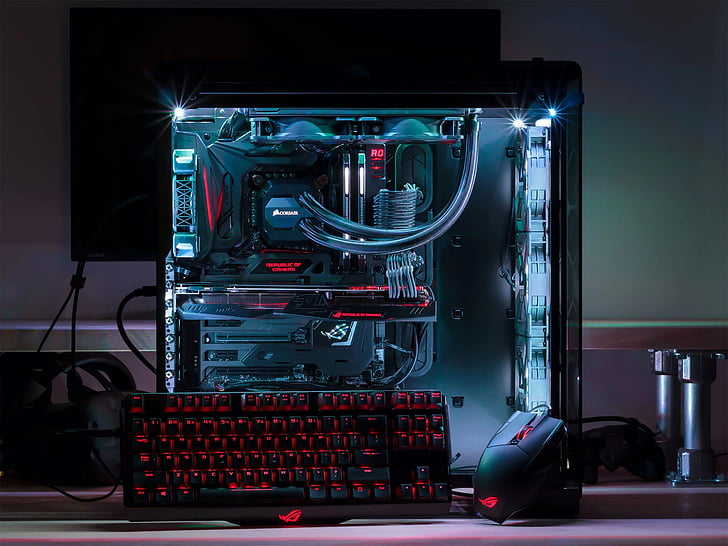Gaming websites are revolutionizing the way players interact with their favorite games. As the digital landscape evolves, these platforms are becoming essential for not just gaming but also for building communities and fostering user engagement. Whether you’re looking for competitive play, social connections, or just a good time, today’s gaming websites cater to a variety of interests and needs.
This overview will explore the top gaming websites that are currently trending, delve into monetization strategies that keep these sites thriving, and analyze the user experience and design elements that draw players in. From the features that enhance gameplay to the revenue models that sustain them, the world of gaming websites is both dynamic and fascinating.
Popular Gaming Websites

Gaming has evolved into a multi-faceted industry, with numerous platforms catering to different preferences and styles. Among the plethora of gaming websites available, a few stand out due to their unique features, extensive game libraries, and vibrant communities. This discussion highlights the top five gaming websites currently trending in the industry, comparing their functionalities and user engagement strategies.
Top Five Gaming Websites
Each of the following gaming websites excels in distinct areas, attracting diverse audiences. Below are the details of these platforms.
- Steam: As a digital distribution platform developed by Valve Corporation, Steam remains a leader in the gaming industry. It offers a vast library of games across genres, seasonal sales, and a robust community hub that includes forums and user reviews.
- Epic Games Store: Known for its exclusive titles and free game offerings, Epic Games Store has rapidly gained popularity. Its user-friendly interface, frequent sales, and support for developers through better revenue-sharing models are key features that attract gamers.
- GOG.com: This platform focuses on DRM-free games, allowing players to purchase and download games without restrictions. GOG.com is particularly popular for its extensive catalog of classic titles and indie games, with an emphasis on user experience and community feedback.
- Origin: Developed by Electronic Arts, Origin provides access to a wide range of EA games and other titles. The platform features social networking capabilities, cloud saves, and subscription services, enhancing the overall gaming experience.
- PlayStation Network: Catering primarily to PlayStation users, this service offers online gaming, digital game downloads, and exclusive content. The PlayStation Network fosters a strong community through multiplayer gaming and social features, connecting players around the globe.
Comparison of Features and Functionalities
The gaming websites mentioned above have unique features that cater to different user needs. Understanding these differences can help gamers choose the platform that best suits their preferences.
- Game Library: Steam boasts the largest game library, while GOG.com focuses on classic and indie titles. Epic Games Store emphasizes exclusivity with free offerings, and Origin specializes in EA games.
- User Interface: Steam and Epic Games Store provide intuitive interfaces, while GOG.com offers a clean, user-friendly layout. Origin’s interface is functional but can be less streamlined compared to its competitors.
- Community Engagement: Steam features extensive community tools, including forums and user-generated content. PlayStation Network encourages multiplayer interactions, while GOG.com fosters discussions around game quality and user experiences.
- Sales and Discounts: Steam is renowned for its seasonal sales, offering significant discounts. Epic Games Store frequently offers free games, while Origin features sales on EA titles. GOG.com often has deals on indie and classic games.
User Engagement and Community Building
Each platform incorporates various strategies to enhance user engagement and foster community building. These strategies contribute significantly to their popularity and user retention.
- Social Features: Steam allows friends lists, group chats, and community hubs where players can interact and share content. PlayStation Network enhances engagement through multiplayer features and trophy systems that motivate gamers.
- User Feedback: GOG.com and Steam prioritize user reviews and ratings, allowing players to make informed decisions based on community feedback. This interaction also helps developers improve their games.
- Events and Competitions: Epic Games Store often hosts events where players can participate in challenges, while Steam organizes seasonal sales events, creating excitement and a sense of community among users.
- Content Creation: Platforms like Steam promote user-generated content, enabling players to create and share mods for games. This not only enhances the gaming experience but also builds a sense of ownership and community among users.
“The strength of a gaming platform lies not only in its library but in its ability to connect players and foster a vibrant community.”
Gaming Website Monetization Strategies
Monetizing a gaming website is crucial for sustaining operations and enhancing user experience. Various strategies can be employed to generate revenue, ranging from advertisements to subscriptions and in-game purchases. Understanding these strategies helps website owners select the most effective models for their audience and content.
One of the primary revenue models utilized by gaming websites includes advertising. This approach can involve display ads, video ads, and sponsored content. Websites like Kongregate leverage ad placements to generate income while providing free access to games. By integrating ads seamlessly into the user experience, these sites can maintain engagement while monetizing effectively.
Subscription Models
Subscription models are another successful strategy, allowing users to pay a recurring fee for premium content or features. This revenue model can create a steady stream of income while also enhancing user loyalty. Platforms like Xbox Game Pass exemplify this strategy, offering a vast library of games for a monthly fee. Subscribers gain access to new titles, exclusive content, and early releases, making the service highly appealing.
In-Game Purchases
In-game purchases have become a significant revenue stream for many gaming websites. These purchases can range from cosmetic items to gameplay enhancements, encouraging players to spend money to improve their experience. For instance, games like Fortnite thrive on this model by offering skins, emotes, and battle passes.
The impact of in-game purchases on overall website revenue cannot be underestimated. They often lead to substantial profits, far exceeding initial game sales. For example, Fortnite reportedly generated over $1 billion in revenue through in-game purchases in its first year alone, showcasing the effectiveness of this monetization strategy.
Diverse Revenue Streams
Combining various monetization strategies is essential for maximizing revenue potential. Many successful gaming websites employ a mix of advertising, subscriptions, and in-game purchases to diversify their income sources. By doing so, they can stabilize their revenue against market fluctuations and changing user preferences.
“Successful monetization relies on understanding the audience and providing value through diverse revenue streams.”
User Experience and Design in Gaming Websites

In the dynamic world of gaming, a website’s design and user experience (UX) are pivotal in determining a player’s loyalty and engagement. As gamers flock to various platforms, it becomes essential for gaming websites to create an inviting and intuitive environment that caters to their needs. A well-crafted user interface (UI) not only attracts visitors but also enhances their overall experience, encouraging them to return time and again.
The significance of user interface design cannot be overstated. A seamless and aesthetically pleasing UI can make navigation effortless, allowing users to find games, updates, or community forums without frustration. Elements such as color schemes, typography, and layout play a crucial role in setting the tone and improving usability. A positive UX ensures that gamers feel comfortable and engaged, which can significantly impact their time spent on the site and their likelihood of sharing it with others.
Best Practices for Enhancing User Experience on Gaming Websites
Implementing best practices in user experience design is essential for creating a gaming website that resonates with its audience. Below are some strategies that can enhance user engagement and satisfaction.
- Responsive Design: Websites should adapt seamlessly to various devices, including desktops, tablets, and smartphones. A responsive design ensures that all users have a consistent experience, regardless of how they access the site.
- Intuitive Navigation: Clear and concise menus should guide users to their desired content effortlessly. Using familiar icons and straightforward labels can help users quickly find what they are looking for.
- Fast Load Times: Optimizing images and reducing unnecessary scripts can significantly improve load times, keeping users from becoming frustrated and bouncing from the site.
- Engaging Visuals: High-quality graphics, animations, and videos can create an immersive experience. These elements should complement the content and not overwhelm the user.
- Community Features: Integrating forums, chat systems, or social media links can enhance user interaction and build a sense of community among gamers.
Features That Contribute to a User-Friendly Gaming Website Design, Gaming websites
Creating a user-friendly gaming website involves incorporating various features that prioritize the gaming experience. Here are key elements that contribute to this goal:
- Search Functionality: A robust search bar that allows users to quickly locate specific games or information enhances usability significantly.
- Personalization Options: Allowing users to customize their profiles or dashboards can create a more tailored experience. This personalization makes them feel more connected to the platform.
- Accessible Content: Ensuring that all content is easy to read and understand, with excellent contrast and legible fonts, caters to a diverse audience.
- Clear Call-to-Action (CTA): Prominent and well-placed CTAs encourage users to engage with content, whether it’s signing up, downloading games, or participating in discussions.
- Regular Updates: A dynamic website that frequently updates its content keeps users informed and engaged, encouraging them to return regularly for new experiences.
“An engaging user interface is the gateway to a delightful gaming experience, influencing player retention and satisfaction.”
If you’re looking for a quick and entertaining way to pass the time, flash games are a great choice. These online games are easily accessible and offer a wide variety of genres, from action-packed adventures to brain-teasing puzzles. Whether you have just a few minutes or a longer break, you can dive into these engaging experiences without any hassle.
If you’re looking for a fun way to pass the time, you should definitely check out flash games. These online games offer quick and entertaining gameplay, perfect for a short break or when you’re on the go. They come in various genres, so there’s something for everyone, whether you enjoy puzzles, action, or strategy. Dive in and discover your new favorite pastime!

